In a few years, it is probable that we will say: “Do you remember when everything was done without artificial intelligence?”
Artificial intelligence is a tool that has been in many domains in modern life. In simple words, it is about making computers perform tasks that today are performed by human beings, analyzing large amounts of data (big data), but with more efficiency, speed, precision and process standardization. This has long been used in many spheres of everyday life and has started to be used in medicine as well. Of course, as expected, reproductive medicine is not an exception and, for some time, in many areas the use of artificial intelligence for different issues has been evaluated.
One of the objectives that has been pursued since the initial times of the in vitro fertilization, is the selection of the best embryo to transfer. Making an adequate ranking of embryos based on the probabilities of success would allow patients to achieve a pregnancy as soon as possible, shortening what is called the “time to pregnancy”. In addition, if it allows selecting those who have the least chance of having a spontaneous miscarriage, that will constitute, per se, an additional advantage. Although this has already been partially achieved by allowing the embryos to evolve to the blastocyst stage, and by making a biopsy of these blastocysts to do PGT-A, optimization has not yet been achieved. Since several years ago, researchers have been working on evaluating the morphokinetics of embryos, taking photos and continuous filming (time-lapse), and evaluating them by using algorithms with artificial intelligence, to identify small changes and analyze all the data obtained, in order to carry out a better embryonic selection. The current published evidence is not convincing yet. But it seems that there is going to be an opportunity for improvement. Science continues to evaluate more data to improve predictive algorithms.
An attempt to select the sperm through the use of artificial intelligence has also been done. The objective, in this case, is even to improve the success rates, since an ICSI could be performed using the sperm with the best reproductive potential. Artificial intelligence could be used to select sperm by morphology and DNA fragmentation. It could also be helpful in identifying sperm in testicular biopsies.
Another area that could have a benefit from artificial intelligence is the prediction of success and the personalization of treatments. Having an enormous number of variables analyzed, each one of them, individually, will allow us to understand, in a more accurate way, the probabilities that each patient has of having a successful treatment. In addition, the knowledge of these details could allow us to make a selection of the type of stimulation that best suits that patient.
In summary, artificial intelligence is a tool that does not have firm evidence to support it for routine use yet, but it is remarkable that we are in the experimental phase in a number of areas that could substantially modify the reproductive medicine in the near future.



